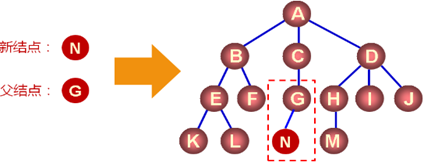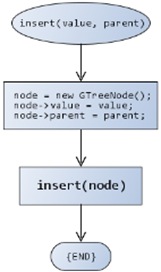1,通用树中的插入操作是以查找操作为基础的;
2,插入的方式:
1,插入新结点:
1,bool insert(TreeNode<T>* node)
2,插入数据元素:
1,bool insert(const T& value, TreeNode<T>* parent)
3,如何指定新结点在树中的位置?

1,问题分析:
1,树是非线性的,无法采用下标的形式定位数据元素;
2,每一个树结点都有唯一的前驱结点(父结点);
3,因此,必须先找到前驱结点,才能完成新结点的插入;
4,新结点的插入:

1,插入操作不是递归实现的;
2,插入操作在查找操作帮助下是非常容易实现的;
3,要插入结点,只用关注父结点中的关于子结点部分(child 链表),至于插入结点的 parent 和 value 不是自己维护的范围,已经被插入者维护好了;
4,代码实现:
1 /* 实现从 Tree<T> 中继承而来的纯虚函数没有插入操作的时候,无法构建一棵树插入操作是构建树的唯一操作,非递归*/ 2 bool insert(TreeNode<T>* node) 3 { 4 bool ret = true; 5 6 if( node != NULL ) // 不能插入空结点 7 { 8 if( this->m_root == NULL ) // 插入的树是空树 9 { 10 node->parent = NULL; // 新结点是根结点,树中通过插入结点的父对象来唯一标识这个结点 11 this->m_root = node; 12 } 13 else 14 { 15 GTreeNode<T>* np = find(node->parent); // 插入结点的父结点是不是在树中 16 if( np != NULL ) 17 { 18 GTreeNode<T>* n = dynamic_cast<GTreeNode<T>*>(node); 19 20 if( np->child.find(n) < 0 ) // 当前要插入的父结点没有需要插入的子结点,返回值小于 0 21 { 22 np->child.insert(n); // 插入到父结点的子结点链表里面去 23 } 24 } 25 else 26 { 27 THROW_EXCEPTION(InvalidOperationException, "Invalid parent tree node ..."); 28 } 29 } 30 } 31 else 32 { 33 THROW_EXCEPTION(InvalidParameterException, "Parameter node cannot be NULL ..."); 34 } 35 return ret; 36 }
5,数据元素插入:

1,只用维护插入结点的 parent 和 value 以及父结点的 parent 就可以了,至于自己的 child 链表,还是个空链表,不用管,而父结点的 child 是要维护的,用新结点插入方法维护;
2,代码实现:
1 bool insert(const T& value, TreeNode<T>* parent) 2 { 3 bool ret = true; 4 GTreeNode<T>* node = GTreeNode<T>::NewNode(); // 使用工厂方法 5 6 if( node != NULL ) 7 { 8 node->value = value; 9 node->parent = parent; 10 11 insert(node); // 本文 4.4 中 insert 函数复用 12 } 13 else 14 { 15 THROW_EXCEPTION(NoEnoughMemoryException, "No memory to create new tree node ..."); 16 } 17 18 return ret; 19 }
6,插入新结点的操作中,新结点的 child 都不用管;
7,小结:
1,插入操作是构建树的唯一操作;
2,执行插入操作时必须指明结点间的父子关系;
3,插入操作必须正确处理指向父结点的指针;
4,插入数据元素时需要从堆空间中创建结点;